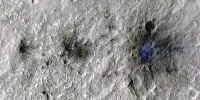The strongest Mars quake ever has been detected by NASA’s InSight lander. With a magnitude of 5, this earthquake is more than six times as powerful as the previous record holder, a 4.2 magnitude tremor that rocked the ground for 90 minutes in September 2021. This one was not nearly as lengthy as the last one, but it was certainly longer than any other quake on our planet, lasting roughly 30 minutes. The latest quake is little in comparison to Earth’s, but it’s dangerously near to the maximum theoretical limit for Mars, which lacks plate tectonics.
The more than 1,300 Marsquakes identified by InSight have been used as a sonogram for the planet’s innards. The varied strata alter seismic waves as they travel through Mars. It is possible to learn more about what happens under the surface of Mars by examining these changes. A quake of this magnitude will reveal much more information about Mars’ innards. “We’ve been waiting for ‘the big one’ since we placed our seismometer down in December 2018,” said Bruce Banerdt, InSight’s principle investigator at NASA’s Jet Propulsion Laboratory.
“This quake will undoubtedly bring a unique perspective on the world. For years to come, scientists will be examining this data to learn new things about Mars.” Quakes are shaking the world’s surface owing to a build-up of strain, whether on Earth, Mars, or even the Moon. This occurs on Earth because tectonic plates continually push against one other as they float on a magma ocean underneath them. However, Earth is special in this regard. Without tectonics, extraterrestrial quakes are less strong and last longer.
The cooling of the Martian interior is thought to be the source of Marsquakes. Materials contract as they age in this process, which is typical in terrestrial environments. This is the process that builds up tension on Mars and releases it sometimes through crust breaking. To properly define the incident, the team will need to perform more research. A greater quake is unlikely to be detected, and not simply because they are infrequent.
The mission of the NASA lander InSight has been extended until December, although it is presently fighting the elements. Winter is approaching in its hemisphere, and the Martian atmosphere’s increased dustiness has drastically reduced the quantity of sunlight reaching its solar panels. Because of this, the lander entered safe mode on May 7, stopping all but critical activities. We’re cheering for you, InSight.
















